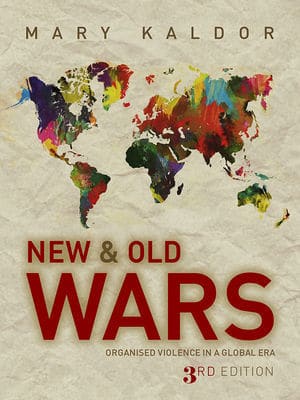An important book since its first edition, the third edition of Kaldor’s New and Old Wars struggles to keep pace with the most recent outbursts of organised violence that rage constantly across the globe. Well aware of this, Kaldor adds a preface to address the new challenges whilst also taking the time to address some of the issues raised by her critics and reviewers in an afterword.
A basic definition of the concept is given in the introduction, thereby providing a clear starting point:
New wars involve networks of state and non-state actors and most violence is directed against civilians (p. vi).
This differentiates new wars from civil wars through the merging of internal and external dimensions and an acknowledgment that despite being essentially localised, these conflicts “involve a myriad of transnational connections” (p. 2).

Remittances, assistance from the diaspora, involvement of foreign governments, humanitarian assistance: the fragmentation of the political landscape of the state has a striking parallel in the implosion of the war economies, through which multiple and diverse economic channels are activated and exploited (p. 109-110).
Since new wars are centred on particularistic aims, and grounded on the principles of exclusion, a cosmopolitan approach, the sense of a larger human community, sharing “rights and obligations” and “tolerance, multiculturalism, civility and democracy” (p. 123) should be recovered. Kaldor is well aware of the critics of military interventionism and the humanitarian wars in Kosovo, Iraq, Afghanistan and Libya (p. 120). How, then, to move on from this conundrum, termed by Chomsky no more than military humanism (Chomsky, 1999)? A crucial factor in conflict resolution appears to be the involvement of local groups and NGOs, “local advocates of cosmopolitanism” (p. 131), and especially those managed by women. A whole chapter is then devoted to the analysis of Afghanistan and Iraq wars, a strange combination of old and new wars, especially after the formal end of the conflict with Saddam Hussein and the beginning of the insurgency. In previous editions of the book, Kaldor stuck with the Balkans as the preferred examples of new kinds of wars, but the evolution of the Iraq situation that eventually spilled over into Syria and animated groups in the whole region, up to Libya and even beyond under the black banners of the Islamic State, is surely something that will require a much larger analysis in the years to come.
The last chapter, Governance, Legitimacy and Security, tries to map ways out of the chaos. Opposing Huntington’s theory of the clash of civilizations, and Kaplan’s ‘coming anarchy’, Falks’ ‘cosmopolitan governance’ seems, and rightly so, to strike a chord. Despite the intrinsic difficulties, unlike Huntington and Kaplan, Falks does not nurture and foster future conflicts. Or does he? Kaldor seems quite convinced that the most reasonable option is to create “agents of legitimate organized violence under the umbrella of transnational institutions” (p. 198).
The concept of new wars is certainly very interesting, and at the same time and to a certain extent, still very problematic: a number of critics have raised important issues that this new edition does not seem to solve, despite acknowledging them.
As pointed out by many critics, violence directed against civilians was a feature already well represented in old wars, especially in Colonial contexts (Ferguson and Whitehead, 1991) and in World Wars.
After WWII, too, civilians were almost constantly at the forefront of conflict fought under the overarching framework of the Cold War. Insurgency and in particular counter-insurgency forces targeted regular troops and civilians, conducting sweeping operations in open daylight and nocturnal kidnappings, torture-sessions and murders. Death-squads were obviously tied to local political forces, and those same forces were engaged in multiple entanglements extending well beyond the state boundaries. The reality of Cold War conflicts was already engrained with several of the mechanisms we see today within the theatre of war.
Talking about state weakness, Kaldor frequently uses the category of “failed state” to imply that a weak state is a threat to security due to the proliferation of non-state actors and criminal networks. However, the most recent wave of conflicts (Libyan, Syrian and Ukrainian wars) has seen the outburst of inherently internal conflicts after external influences, which fuelled the escalation of purely local demonstrations into armed uprisings, fostered by international actors siding with different groups to protect, in most of cases, their vested interests. Regarding Afghanistan and Iraq, instead, it seems that these countries were in fact the places where new wars, counter-insurgency and nation-building were tested from above, especially in Iraq: for the creation of private networks of contractors to provide services for every aspect of public life; and for implementing an obvious divide et impera between the Sunnis, Shias and Kurds. The Petraeus turn, the so-called Surge, and the Human Terrain System experiment, moreover, constitutes a revolutionary effort by the US military apparatus to cope with the new challenges, rather than a return to old war concepts. Even the air-strike campaign through a grossly illegal use of Unmanned Aerial Vehicles which worsened security conditions, can be seen as a shift towards a disturbing future of targeted killings, denying any legal framework to the supposed insurgents already included in the very problematic category of enemy combatants.
Regarding the role of cosmopolitan transnational institutions involved in law-enforcement, Kaldor herself is well aware that there is always an intrinsic danger lying at the core of every universalist project.
The most recent forms of new wars witnessed today are already remarkably different from the Balkan, Afghan or Iraqi wars.
The Islamic State, for example, contradicts many assumptions formulated so far: it is local, rooted in the Sunni insurgency in Iraq, but also international, attracting militants (a trend already seen in the jihadist movements of the 1980s) in order to fight for a universalistic project: inclusive (the creation of a state of the Ummah), and exclusive at the same time.
When the book was first published in 1999, Kaldor established herself as one of the key-scholars addressing the changing nature of warfare after the collapse of Soviet Union and the end of the Cold War. The ensuing collapse of a previously united Yugoslavia, and the grim episodes of brutality against civilians on an ethnic basis on a scale never seen in Europe since WWII, seemed to constitute a model for a new wave of conflicts that were developing and simmering all across the globe. After 9/11 and the following war(s) on terror, the book became immensely popular. While non-state actors came to the forefront of almost every confrontation, state actors too remained relevant: the privatisation of armed forces and contractors became integral parts of the state war-machine, and the boundaries between state and non-state became increasingly blurred. Further editions of the book (1999, 2007 and 2012) could be seen as an effort to keep track of changes as we see them:
the wave of conflicts that started at the beginning of the 21st century has not ceased, but has taken unexpected turns, and appears to be constantly evolving.
Kaldor is aware of the difficulties in defining what is happening to warfare, and hints herself at many of the critical assessments raised against her arguments in the different editions. The importance and strength of this book ultimately lies in that: it is still a good point from which to start thinking about the evolution of warfare and its implications on a global scale.
Bibliography:
Chomsky, Noam. 1999. The New Military Humanism: Lessons from Kosovo. London: Pluto Press.
Falk, Richard A. 1995. On humane governance: toward a new global politics. Penn State Press.
Ferguson, Brian R. & Neil L. Whitehead (eds.). 1992. War in the Tribal Zone. Expanding States and Indigenous Warfare. Santa Fe: School of American Research Press.
Huntington, Samuel P. 1996. The Clash of Civilizations and the Remaking of World Order. New York: Simon & Schuster.
Kaplan, Robert D. 2000. The Coming Anarchy. Shattering the Dreams of the Post Cold War. New York: Random House.
Kaldor, Mary. 2012. New and Old Wars. Organized Violence in a Global Era. (3rd Edition). Cambridge: Polity Press. 224 pp. Pb: €22.50. ISBN: 978-0-7456-5563-5










